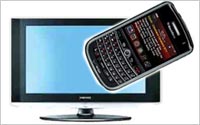 When the TV goes on, the cell phones
come out. According to a new joint survey of U.S. mobile phone users by Razorfish and Yahoo, 80% of respondents say they regularly use their cell phones while watching TV, with 70% of those
mutlitaskers doing the two-screen tango at least once a week and a staggering 49% second-screening every day.
When the TV goes on, the cell phones
come out. According to a new joint survey of U.S. mobile phone users by Razorfish and Yahoo, 80% of respondents say they regularly use their cell phones while watching TV, with 70% of those
mutlitaskers doing the two-screen tango at least once a week and a staggering 49% second-screening every day.
While 60% of mobile multitaskers check their phones once or twice during a given
program, 15% say they are browsing throughout their TV time.
The findings are recounted in a chapter from the latest Razorfish Outlook Report by vice president of emerging media Jeremy Lockhorn, which says this new media
consumption behavior can be as disruptive as it is promising to TV and ad viewing as we know it.
“At minimum, multitasking adds another layer of complexity to the evolution of media
measurement,” Lockhorn writes. “At most, it’s a massive disruptor to television. ... On the one hand, there is a potential distraction factor with connected devices, and on the
other, there is a much more engaged viewer who is passionately chasing down more content on devices beyond the TV.”
The consumers themselves are not entirely sure which is the case.
When asked whether their connected devices enhanced the viewing experience or distracted from it, equal percentages of 38% agreed with one or the other statements. Reality programming, news,
comedy, sports and food in that order inspire mobile multitasking most.
Mobilized viewers are using devices to do what they do best -- communicate. Ninety-four percent of mobile mutlitaskers
are directly contacting others via text, email, voice, social networking or other messaging -- in that order. But 60% of multitaskers are drilling further into some content, although 44% of it is
unrelated to what they are watching and 38% is related to TV.
Still, marketers can take heart. Amid the person-to-person distractions and mobile Web browsing, 36% do say they use their
devices to look up more information on the TV spot they just watched. Tablets, however, may be an important source of tandem programming. The survey finds that 57% of people using tablets while
watching TV are often searching for related content.
As Yahoo has reported previously, mobile phone use does spike during commercial breaks on TV, and the mobile usage patterns remain pretty
much as they are when the main program is on.
Lockhorn recommends that marketers prepare for the synergies between TV and mobile by creating seamless experiences across the
screens. More than simply making a mobile Web site, marketers need to ensure continuity.
“It means a mobile-optimized site that knows what’s happening in the TV spots, and
perhaps even what is happening in the current program --especially if it is live. At a bare minimum, it’s time to consider what kind of mobile call to action may be appropriate in a
brand’s TV spot.”
Also critical will be social networking strategies that get a brand into the person-to-person watercooler discussions that are happening via mobile during
shows.
Ultimately, multitasking and the distractions it may cause could further dislodge faith in the Gross Rating Points method to measure the TV audience, Lockhorn admits. But in
the long run, mobile devices will help programmers and advertisers better understand what people are watching and even what buying behaviors emerge from their new patterns of media consumption.